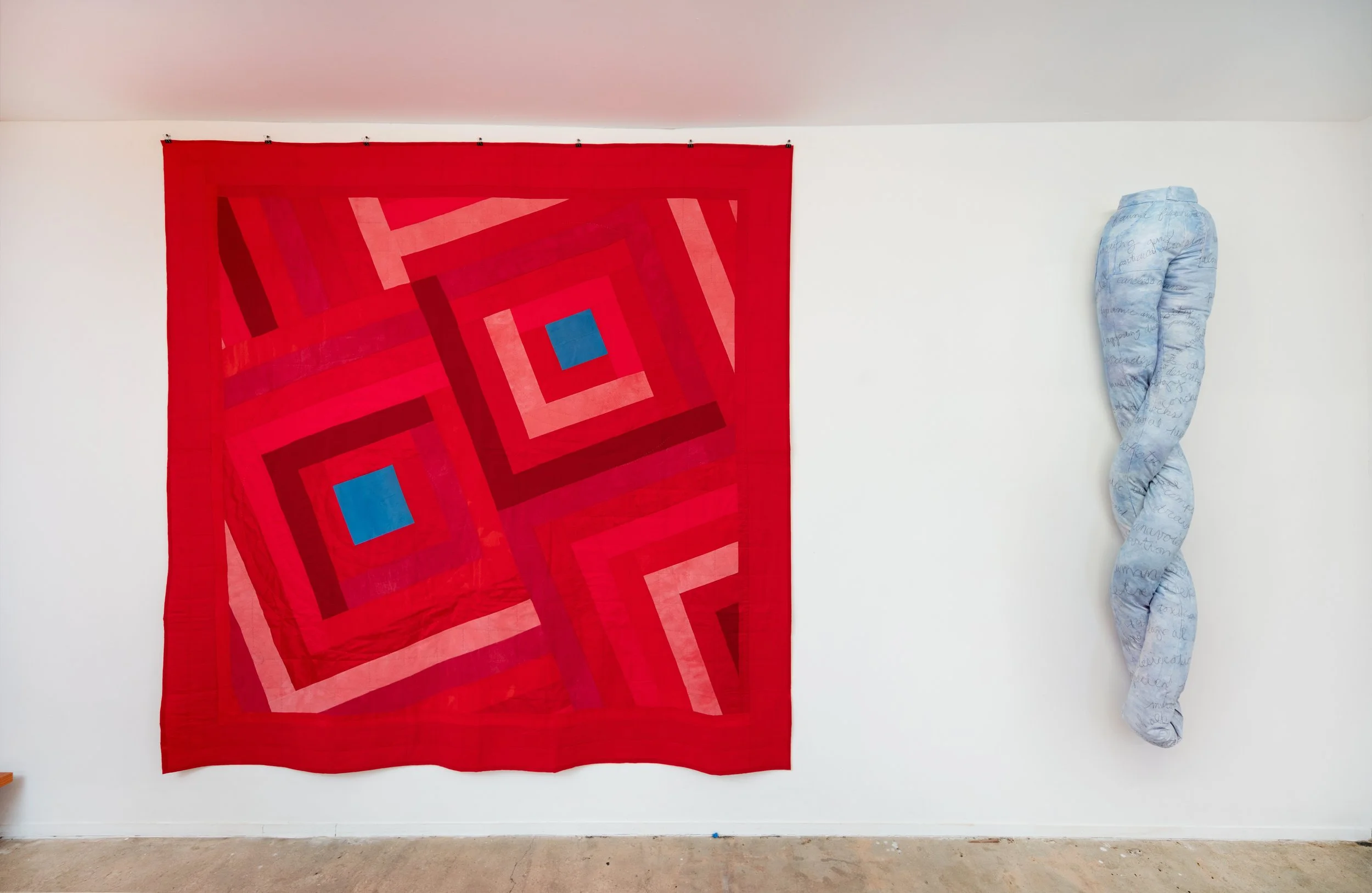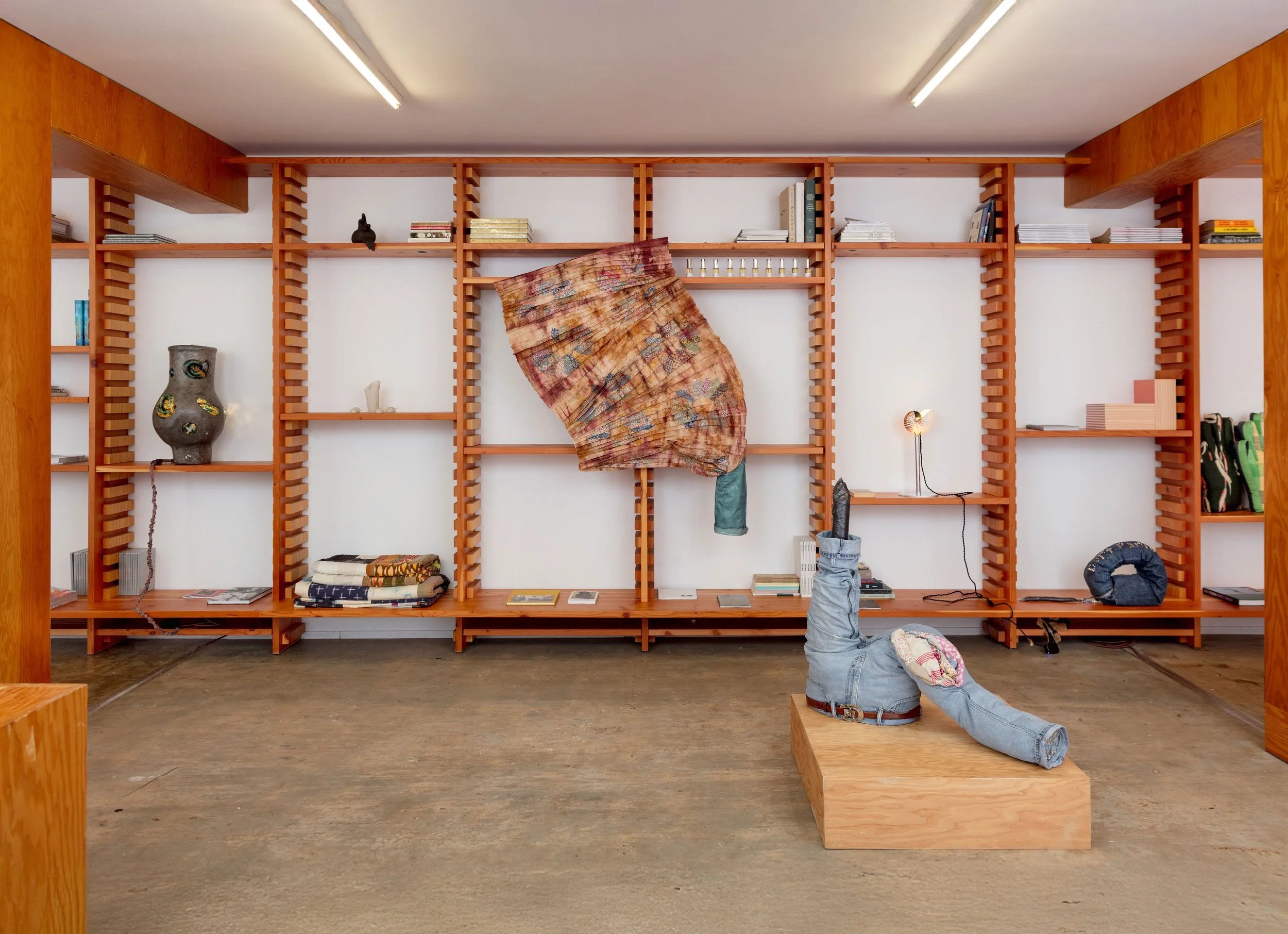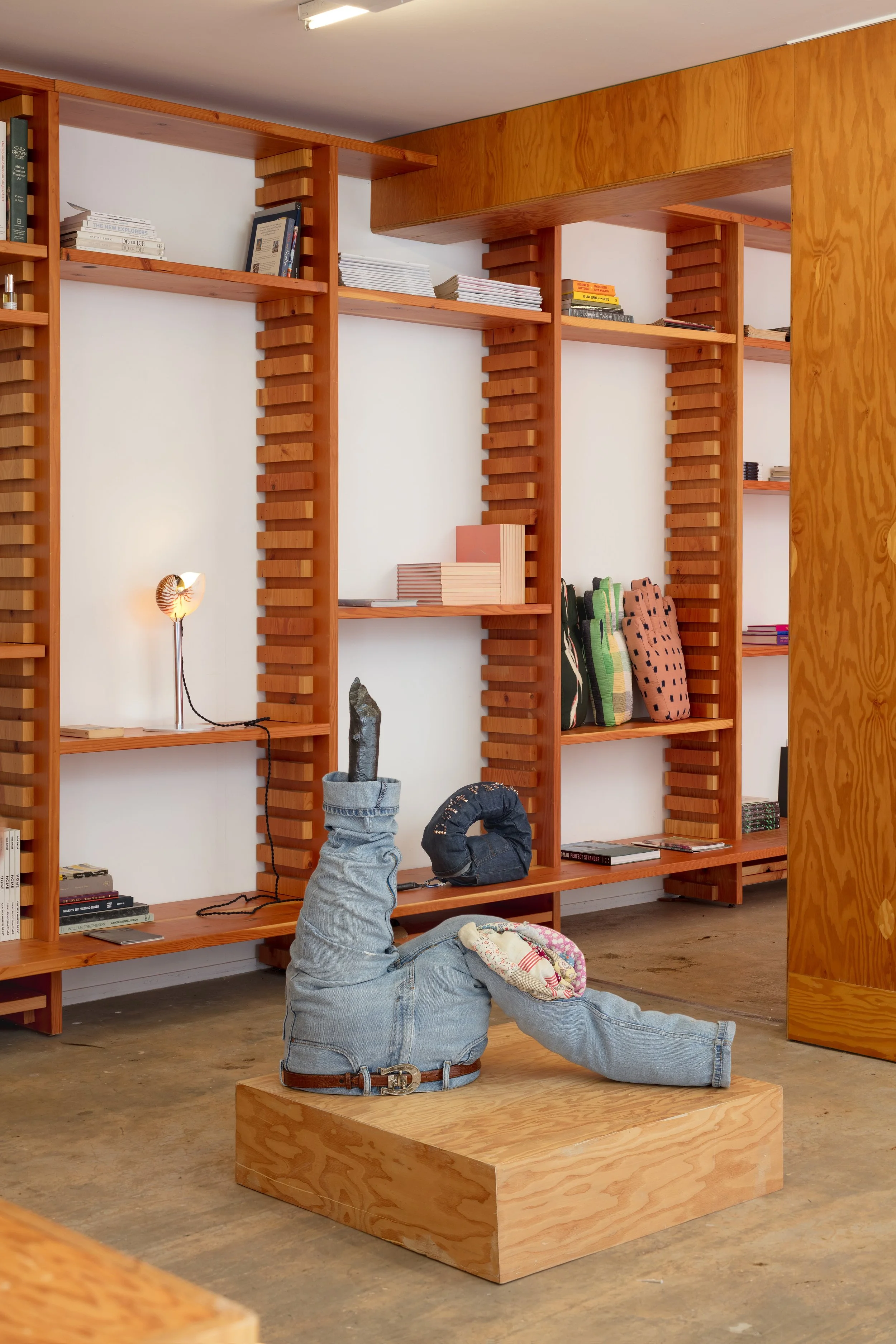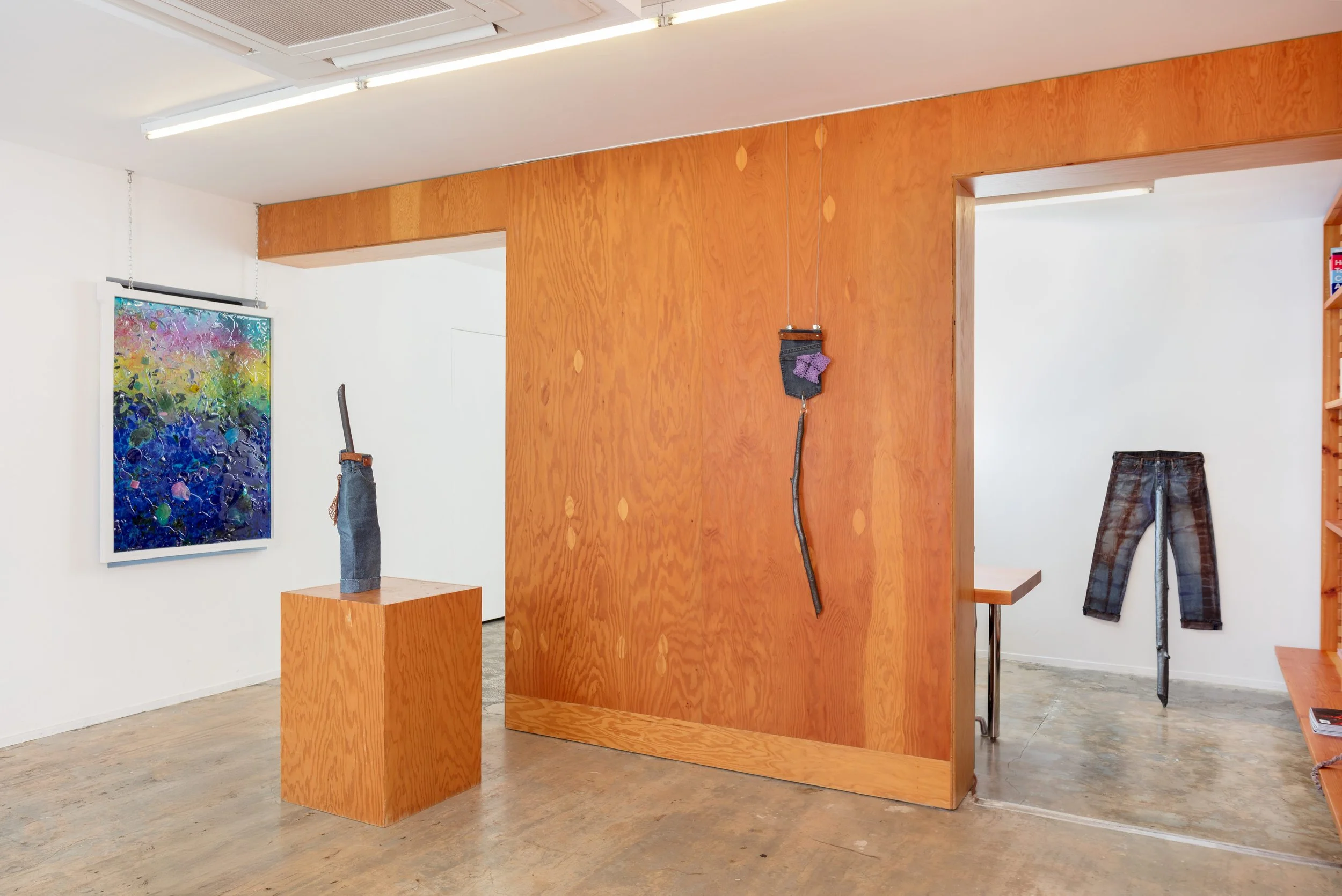Cruising the Margins: Christy Gast’s Intimate Materiality
Tucked inside a modest annex at Nina Johnson, Cruising // the stacks, Christy Gast’s most recent exhibition, offers a tender and tactile meditation on queer desire, material kinship, and feminist world-building. While the setting evokes the casual accessibility of a bookstore or gift shop, the richness of Gast’s subtle, deeply researched objects calls for a venue that honors their complexity. This is not a show to stumble upon—it demands to be centered.
Gast’s practice is sculptural in the broadest sense of the word—not only in form, but in the way she shapes attention, curiosity, and memory through matter. As she reflects in her studio notes, “the contrast between hard and soft” animates her thinking: body and clothing, desire and structure in constant interplay. Her chosen materials (vintage denim, found quilts, leather, lace, stainless steel studs, beaver-chewed wood) are not neutral substrates. They are storied surfaces, inscribed with use, gender, and vibrancy. Gast’s process is one of loving labor—channeling overlooked archives, gathering fragments of lesbian and feminist herstory, and reanimating them as devotional objects.
The title, Cruising // the stacks, works on many levels. To “cruise the stacks” is to seek both knowledge and connection in the aisles of libraries or archives and, more figuratively, to search through the layers of cultural sediment that have buried feminist legacies. Gast doesn’t simply unearth these stories; she renders them poetically monumental. Her work speaks to intimacy, not only between people, but between matter and maker, viewer and object.
A standout in the exhibition is Gloria (2025), a sculptural textile piece that gathers multiple lineages into a single form. It begins with a classic fan-motif quilt—an aesthetic associated with women’s domestic labor and improvisational creativity. Gast’s interventions use cochineal and goldenrod dyes applied with resist techniques that follow the quilt’s pleats and folds. From this foundation, the piece spills upward from a polished pocket of vintage cut-off denim, forming a lush crescendo of textile and color.
The reference to Gloria Vanderbilt—the artist, heiress, and designer known for her maximalist interiors and denim empire, whose kaleidoscopic, patchwork-encrusted bedroom shimmered with patterned excess—is both humorous and reverent. Vanderbilt’s bedroom was photographed in various stages over the years, most notably by Jonathan Becker for Vanity Fair and Architectural Digest, where it remains a visual archive of unapologetic self-expression and domestic theatricality.
There’s a compelling tension here: Vanderbilt, a woman of immense inherited wealth, made her mark by branding denim, once the fabric of miners and mechanics, as an aspirational luxury. By contrast, Gast descends from an Ohio family working in agriculture and antique malls. In that lineage, denim was never fashion; it was uniform, practicality, and perhaps also early aesthetic training surrounded by secondhand glassware, vintage signage, and the quiet drama of curated clutter. That vernacular sensibility—part resourcefulness, part cultural remix—finds its way into the work, not as nostalgia, but as reimagined inheritance. Gast’s Gloria ascends the gallery wall with similar theatricality, though rooted in a different kind of glamour: one stitched from hardworking factory folk, lesbian pride, common sense, and manual intelligence. Here, domestic crafts and a taste for butchiness do not contrast, but conspire. And in a show filled with layered gestures and generous collaborations, Gloria emerges as a quiet anchor, holding within it a universe of feisty extravagance, resilience, and wit.
Another anchor is the piece that gives the show its name, Cruising (2025). The tactility of this piece is key—not just what it’s made of, but how it invites the viewer into an unspoken reading of gender, class, and landscape. What looks like a styled, patchwork vaginal form is sculpted into the bent leg of a pair of upside-down jeans. Denim, as Gast notes, is tough by design: a textile of laborers and now sculptors who subvert its history with tenderness. Its indigo-dyed twill resists water and wear, but here it becomes a porous vessel for memory. The one standing leg grows taller with one of the many beaver-carved sticks that Gast has collected near her home in Dutchess County, New York.
That soft–hard tension echoes across the show. Even the hardware used to mount the pieces (climbing harnesses, O-rings, strap-ons) underscores the erotics of utility. These objects don’t dramatize sexuality; they carry it quietly, folded into their structures, always brushing against something else. That erotic infrastructure becomes most visible in Don’t Panic (2025), a sculptural loop of denim formed using a single leg from a pair of jeans. The cuff slips neatly into its own waistband, creating a taut, self-consuming spiral, while the outer curve bears the title spelled out in metal studs—a nod to the “Dyke Tactics” leather jacket preserved in the Lesbian Herstory Archives.
Throughout the exhibition, Gast’s sensibility is one of care and connectivity. She eschews spectacle in favor of closeness. Intimacy is carded into fibers; memory, pressed into fabric. There is a choreography of coded signals at play—chain wallets, gender-neutral denim, mirrored disco textures—gesturing toward both nightlife and archival longing, sweat and stitching, the small ways we fashion ourselves into constellations.
These garments aren’t meant to be worn, but they radiate protection: soft armor against erasure. There are echoes of non-gender-conforming domesticity, of DIY resistance, and of the rituals of reading that shape and shelter desire. Other works—twisted dungarees, beaver-sculpted sticks embedded in denim, all soft sculptures—extend the show’s material vocabulary. They are sensual without being performative.
Importantly, Gast does not claim the space alone. Cruising // the stacks is also a community act. In the second part of the exhibition, // the stacks, she curates fellow artists’ contributions, each exploring their own engagements with intimacy, archival work, and tactile knowledge. This decision opens the show outward, away from the solipsism that can accompany solo exhibitions and toward a more collective practice of alternative world-building. It redefines the artist–curator not as gatekeeper, but as host.
Yet, despite the exhibition’s conceptual richness, the staging felt insufficient. The store-like setting diluted the intensity of the pieces, dispersing them across shelves and pedestals that felt more retail than reverent. Gast’s work doesn’t need packaging—it needs breathing room. What might it have felt like to encounter these objects in the main gallery, with light, space, and stillness to absorb their depth?
Gast’s ability to fuse archival tenderness with material experimentation, while building queer kinship through her practice, is reason enough for her to take center stage. Cruising // the stacks isn’t a side project, it’s a tactile manifesto. It should be given the room it deserves.
Christy Gast: Cruising // the stacks is on view at Nina Johnson from September 4 through November 15, 2025.





